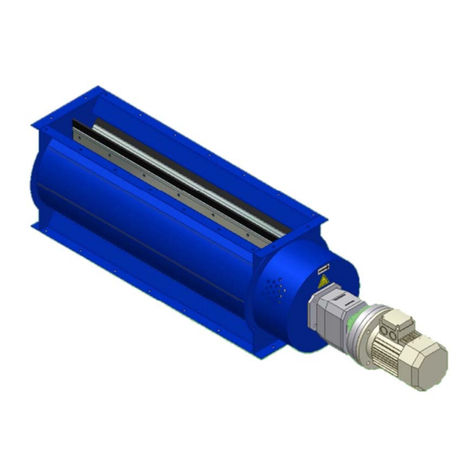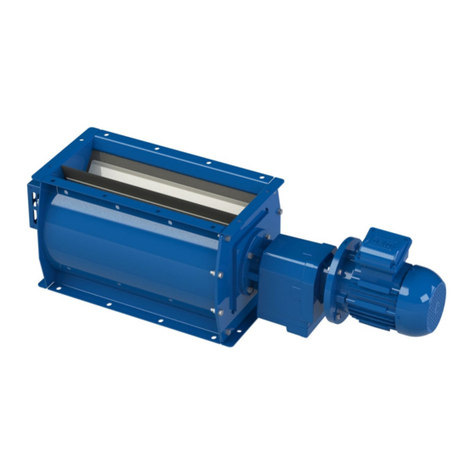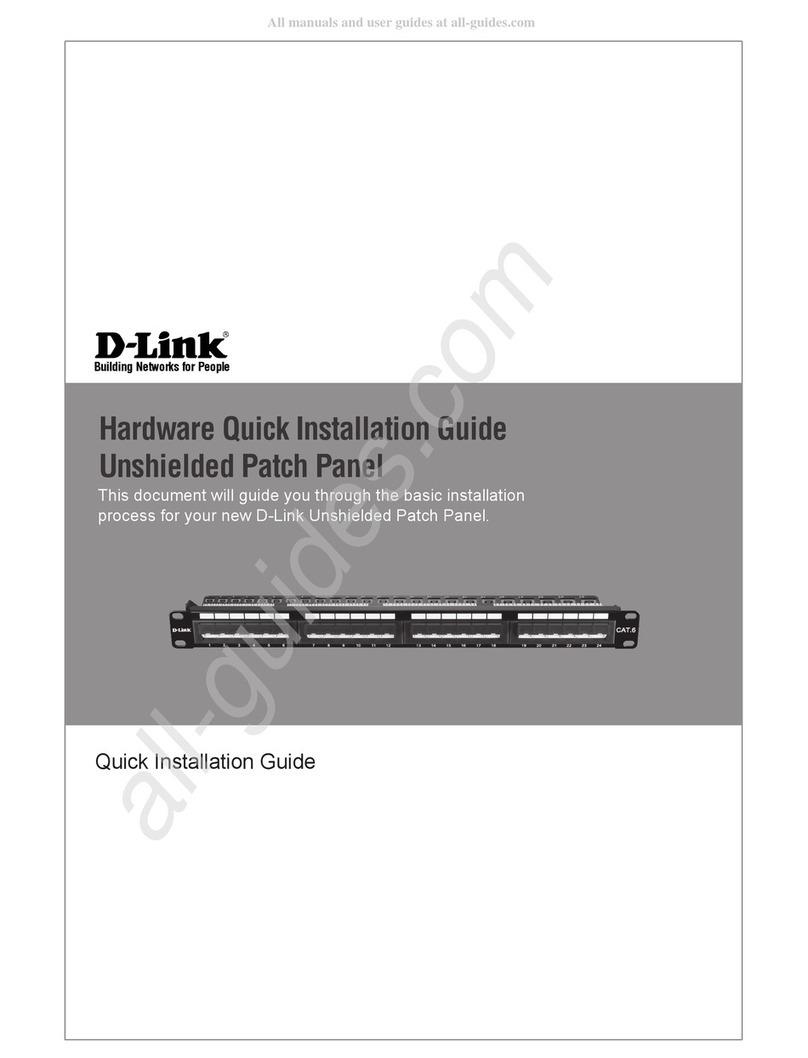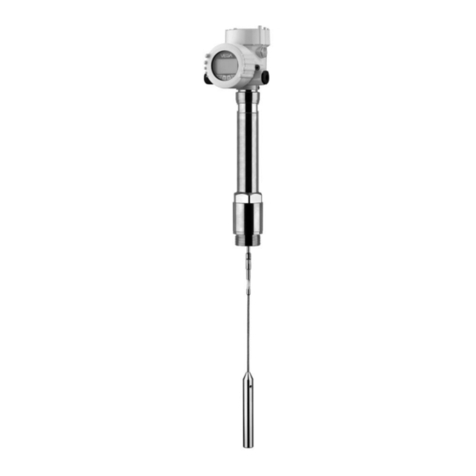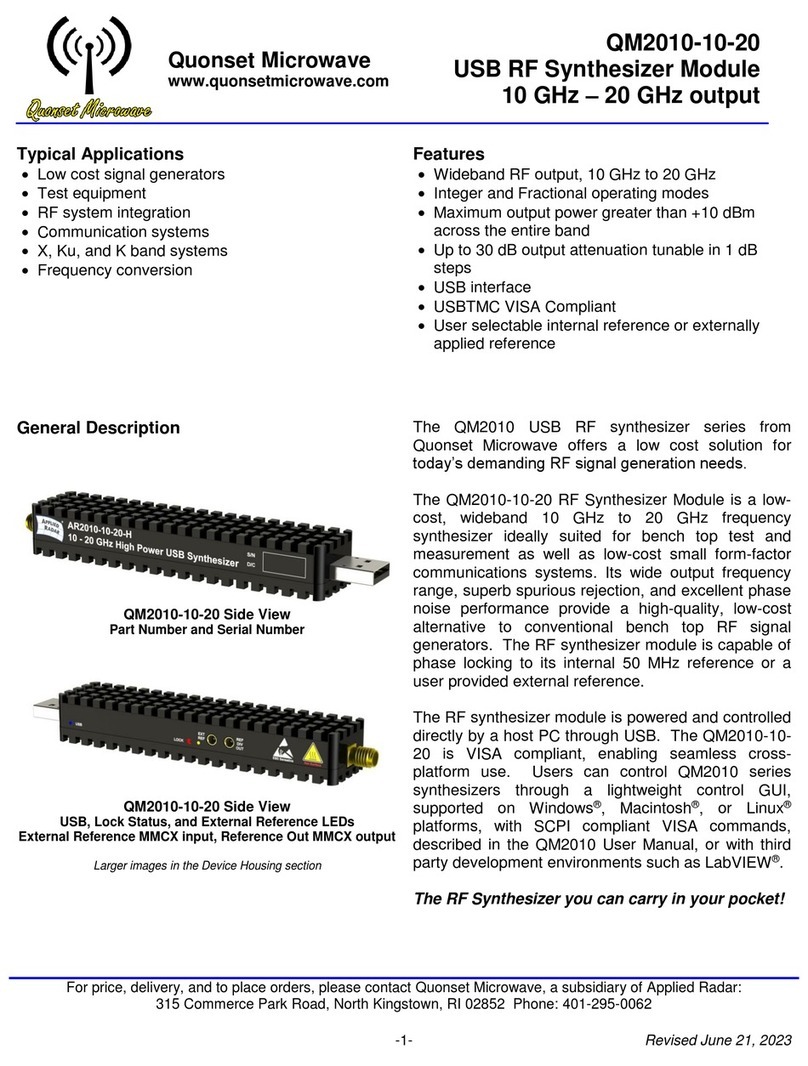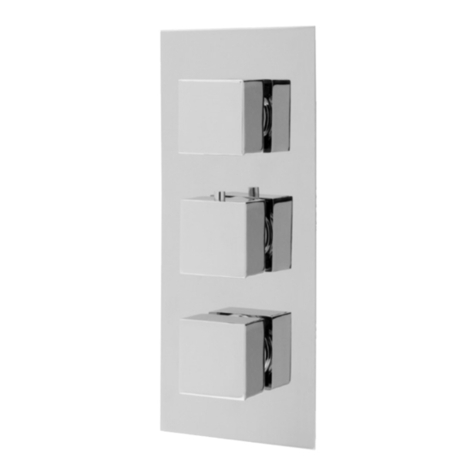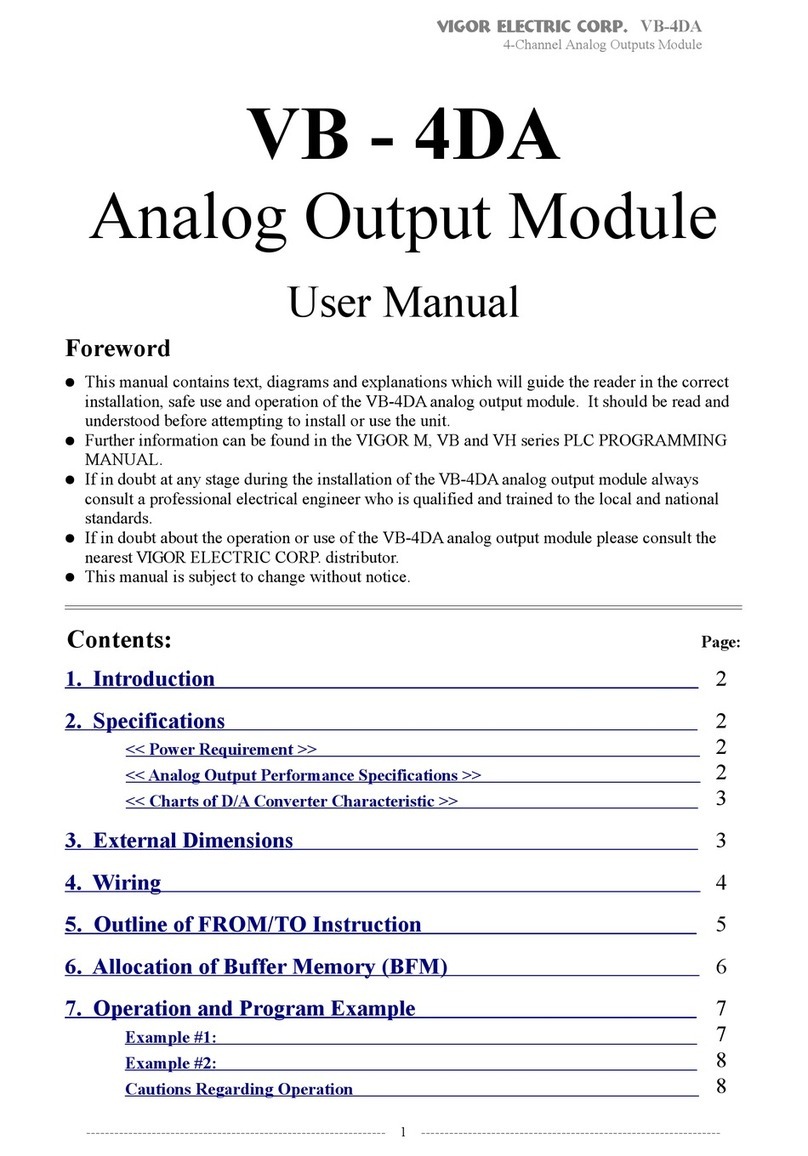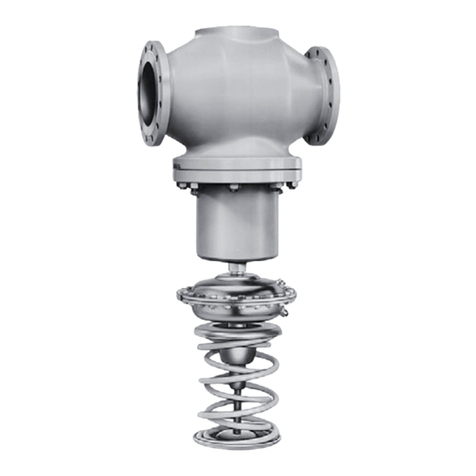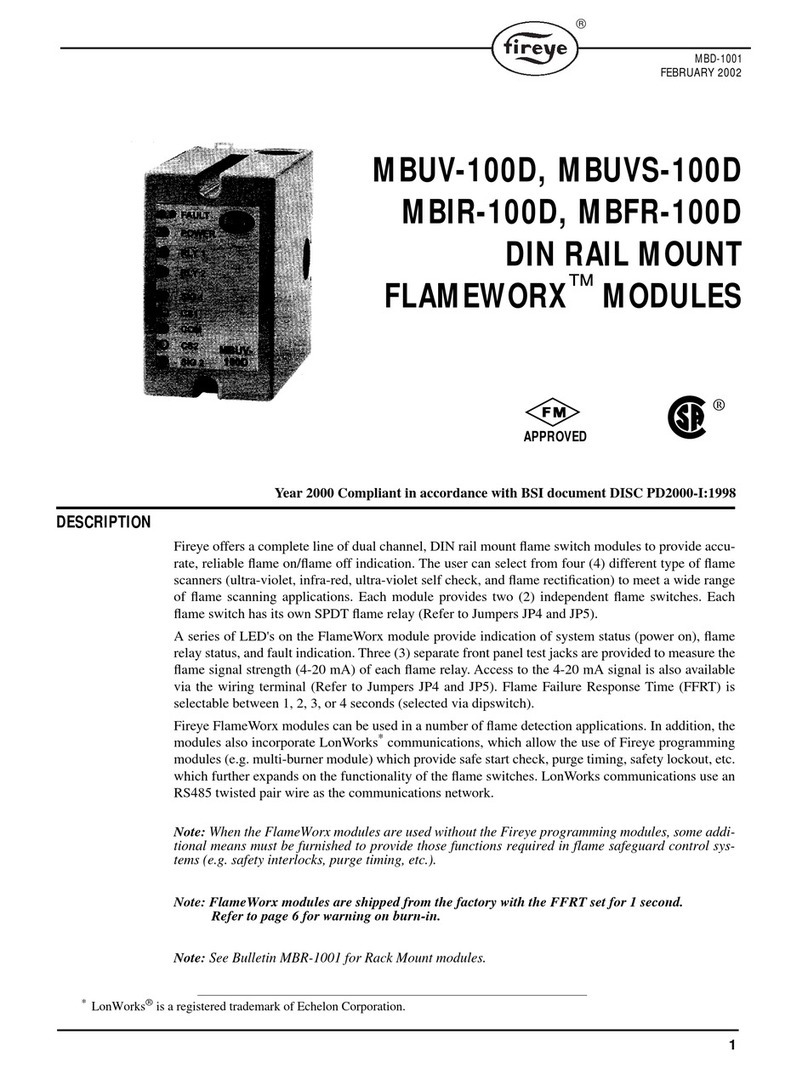Formula Air BADA000018 User manual

BADA ATEX Non-Return Valve
Maintenance Manual

1
Contents
1.
PRODUCT DESCRIPTION .................................................................................................................. 2
1.1
How it works............................................................................................................................ 3
1.2
Overall dimensions.................................................................................................................. 5
1.3
Technical datasheet................................................................................................................. 6
1.3.1
Push flow situation .......................................................................................................... 6
1.3.2
Pull flow situation............................................................................................................ 6
1.3.3
Special conditions for safe use ........................................................................................ 6
2
INSTALLATION ................................................................................................................................. 8
2.1
Valve installation direction...................................................................................................... 8
2.2
Connecting the non‐return valve ............................................................................................ 9
2.3
Precautions for a proper use................................................................................................... 9
3
INSTALLATION ............................................................................................................................... 10
3.1
Maintenance.......................................................................................................................... 10
3.1.1
Cleaning and checking the inside of the non‐return valve............................................ 11
4
ATEX CERTIFICATION ..................................................................................................................... 12
4.1
Potentially explosive atmosphere ......................................................................................... 12
4.1.1
Dangerous areas classification ...................................................................................... 12
4.1.2
Dangerous areas classification ...................................................................................... 13
4.2
ATEX code description........................................................................................................... 13
4.3
Production identification....................................................................................................... 14
5
USEFUL INFO RELATED TO THIS MANUAL..................................................................................... 15
6
DISMANTLING AND RECYCLING .................................................................................................... 16
7
CONTACTS ..................................................................................................................................... 17

2
1.
PRODUCT DESCRIPTION
The non‐return valves are ATEX certificated protective systems which prevent a dust explosion
propagation through the ductwork into other areas. The non‐return valve cannot isolate a dust
explosion when it propagates through the normal air flow direction.
The non‐return valves are not designed to prevent the transmission of fire or burning powder
transported by the normal process flow.
The non‐return valves are built in 3 mm thick 16mo3 steel, powder coated RAL 5010 and the flap
of HB400 (Hardox).
Formula Air Non‐return valves fulfill all relevant requirement to be used safely in an explosion
hazardous environment. To accomplish this, several instructions are described in this manual and shall
be following prior to and during operation.
The following harmonized standards have been applied:
EN‐ISO80079‐36:2016 Explosive atmospheres – Part 36: Non‐electrical equipment for
explosive atmospheres – Basic method and requirement
EN 16447:2014 Explosion isolation flap valves
Figure: 1 shows a non‐return valve.
Figure: 1 Non‐Return Valve

3
1.1 How it works
During the normal process, the non‐return valve’s flap remains opened due to the airflow
(Figure: 2). At deadlock, the valve closes due to the flap’s own weight.
Figure: 2 Non‐Return Valve in open airflow configuration
When an explosion takes place, the ATEX certified non‐return valve blocks the expansion of the
explosion due to the front spreading pressure along the ductwork (Figure: 3).
Figure: 3 Non‐Return Valve in closed configuration
After an explosion and due to pressure oscillations, the valve could re‐open. To avoid the re‐
opening, a safety lock system keeps the valve closed long enough to avoid the propagation of
flames during the explosion event, as can be seen in Figure: 4. The locking system consists of a
spring metal that allows it to bend easily. Therefore, if the flap closes the arm hits the locking
system and the top of the locking system will give in. This way, the flap gets locked beneath the
top plate of the locking system. Once the explosion is completely over, the lock must be

4
in
in
ato
fl
unblocked manually. Before unblocking the valve flap, the complete valve should be checked after
an explosion has occurred for possible damage which could hinder the proper functioning.
Note that the inner flap can also lock itself due to reverse current cleaning of the filter. If this is
the case, the installation distance and reverse flow pressure should be checked to reduce the
effect on the non‐return valve.
Figure: 4 Locking system inside the Non‐Return Valve Figure: 5 Illustration how the indicator works
When the dicator is
this position the flap
inside the non‐return
valve is open
When the indic r is in
this position the ap inside
the non‐return valve is
closed and has to be
unlocked manually

5
1.2 Overall dimensions
Figure: 6 Overall dimensions
Type
Ø d
(mm)
A
(mm)
B
(mm)
C
(mm)
E
(mm)
F
(mm)
S
(mm)
Mass
(kg)
BADA000018
204
470
510
590
137
52
3
45
BADA000019
254
520
555
620
137
52
3
52
BADA000020
304
570
610
640
137
52
3
60
BADA000021
354
620
660
670
137
52
3
70
BADA000022
404
670
710
735
157
52
3
83
BADA000023
454
720
760
785
157
52
3
94
BADA000024
504
770
810
835
157
52
3
106
BADA000025
554
820
860
885
157
52
3
118
BADA000026
604
870
910
935
157
52
3
130
BADA000010
653
985
1021
+/‐ 1090
247
71
3
169
BADA000011
703
1035
1072
+/‐ 1120
247
71
3
185
BADA000012
753
1085
1127
+/‐ 1150
247
71
3
199
BADA000013
803
1152
1213
+/‐ 1220
277
71
3
229
BADA000014
853
1202
1263
+/‐ 1340
277
71
3
241
BADA000015
903
1252
1313
+/‐ 1340
277
71
3
268
BADA000016
953
1302
1363
+/‐ 1340
277
71
3
281
BADA000017
1003
1352
1413
+/‐ 1340
277
71
3
294

6
1.3 Technical datasheet
1.3.1
Push flow situation
Considering the normal process flow direction, the situation where the fan is located upstream of
the explosion source (Figure: 7).
1.3.2
Pull flow situation
Figure: 7 Push flow situation
Considering the normal process flow direction, the situation where the fan is located downstream
of the explosion source (Figure: 8).
Figure: 8 Pull flow situation
1.3.3
Special conditions for safe use
Installation:
−
Installation, operation, maintenance and repair in areas with danger of explosions may only
be carried out by qualified personnel;
−
Ensure that no tools, nuts and bolts or assembly parts remain in the machine during assembly
or maintenance;
−
Selection and installation of the electrical parts within hazardous areas shall be fulfilled
according the EN60079‐14 and the installation instructions of the specificequipment;
−
No potential difference between all metal parts within the non‐return valve, or between
non ‐ return valve and earth may exist. Therefor earthing resistance between all metal parts
and earth shall be measured before operation and shall be maximum 1 MΩbetween

7
individual items and to earth and the connected process structure. An earthing resistance
higher than 10Ωmay indicate bad earth connections;
−
An earth connection is provided externally on both sides and a lid of the valve. The external
earth connections shall be used to bond other process parts with a equipotential bonding
conductor of at least 4 mm2;
−
The valve should only be exposed to organic or non‐metallic dust;
−
Ambient temperature range: from ‐20oC to +60oC;
−
Parameters of the dust: organic non‐metal dust, Kst,max=200 bar.m.s‐1, MIE=13mJ, MIT=430oC.
−
DN 200 – 400: Pull and Push, stright pipes or 2x90obend is allowed between the protected
vessel and the flap;
−
DN 450 – 1000: Pull flow situation, straight pipes between the protected vessel and the flap
and venting on the protective vessel only non‐reclosing vent devices. (this excludes e.g.
suppression and venting with reclosing vent devices);
−
The maximal speed flow is 25 m.s‐1;
−
The maximum dust concentration in the ducting is witout the limit;
−
The product has to be installed so that the propagating brush discharges on the extrenal
surface of the device are avoided:
−
The electrical devices installed together with the back pressure flap must have th etype of
protection corresponding with the defined explosive zone;
−
Flap position is horizontal.
Parameters dependent on the size of the flap:
Parameters of flap (unit):
Sizes DN (mm):
200
250 ‐ 400
450 ‐ 600
650 ‐ 1000
p
red, max
(bar)
0,50
0,50
pmax (bar) design pressure ‐ EN 14460
1
1
0,8
0,70
minimal vessel volume (m3)
0,46
0,96
6
6
minimal installation distance (m)
2,2
3,1
4
4
maximal installation distance (m)
7,2
7,2
7,2
7
maximum allowable opening angle of the blade
to the vertical
60o 60o 60o 50o
inclination of flap valve
horizontal
maximal speed flow (m.s‐1)
25
max. dust concentration in duct where device
will be installed
Without limits

8
2
INSTALLATION
CAUTION! The non‐return valve installation, connection, start‐up and maintenance has
to be performed in absence of potentially explosive atmosphere through the process
interruption.
CAUTION! The installation, connection, start‐up and maintenance of the non‐return valves have to
be performed by qualified personnel. Use the right equipment and costumes, and do not work alone.
2.1 Valve installation direction
For a right installation, the air flow direction in normal working conditions has to be the same as
indicated by the arrows on Figure: 9.
Figure: 9 Installation direction regarding to the Air flow
The non‐return valve needs to be installed horizontally. The inspection panel must always be set
upwards, see Figure: 10.
Figure: 10 Installation direction
Air Flow

9
2.2 Connecting the non‐return valve
For the best isolation effectiveness, the non‐return valve needs to be installed in proximity of the
risk zone which it is wanted to be isolated.
Step 1: Connect the inlet and outlet to the duct system with the correct fasteners.
Step 2: Make sure that the indicator is in the correct position (Figure: 11).
Figure: 11 Indicator Position
2.3 Precautions for a proper use
CAUTION!
−
It is strictly forbidden to open the inspection panel while the installation is running;
−
During maintenance keep the system disconnected and all the electrical equipment turned
off;
−
The valve should not be placed in an environment that could create a vibration in the
non ‐ return valve;
−
After the event of an explosion, do not unblock or manipulate the non‐return valve until the
explosion is completely extinguished. Check if the non‐return valve and its parts are working
properly. Clean the valve. Replace any parts that are damaged!
Make sure the indicator is inthis position
When the indicator is in this position, the
Valve is blocked, and it will block the airflow

10
CAUTION!
Be aware of hot particles remaining inside the valve, even if the explosion is over.
While opening the inspection panel, parts can fall off from the inside, damaging the
operator or goods.
−
Every time there is a potentially explosive atmosphere danger, special safety steps must be
taken, as the following:
Tools or operations which can produce sparks, which can cause gas
ignition, or flammable vapors, are not allowed to be used in any procedure that takes
place in any area classified as explosion risk.
Avoid dust removal by blowing while cleaning.
The use of free flames near the explosion risk area is strictly forbidden.
3
INSTALLATION
CAUTION! The non‐return valve installation, connection, start‐up and maintenance
must be performed in absence of potentially explosive atmosphere through the
process interruption.
CAUTION! The installation, connection, start‐up and maintenance of the non‐return
valves must be performed by qualified personnel. Use the right equipment, clothing and individual
protection devices according to the situation, and do not work alone.
CAUTION! Any modifications done by the user on the non‐return valve are prohibited!!
3.1 Maintenance
Replacement parts must be purchased from original manufacturer to guarantee explosion
protection.
CAUTION! Internal parts of the non‐return valve shall be inspected 2 monthly for signs of
wear. Especially the EPDM valve seal shall be intact and in place. If EPDM valve seal is worn or not
fitted correctly, the seal must be replaced to guarantee explosion safe operation.
Clean and check the performance of the non‐return valve regularly. It is strictly forbidden to open
the inspection panel while the air flow is running through the duct.
During maintenance keep the system disconnected and all the electrical equipment turned off.

11
3.1.1
Cleaning and checking the inside of the non‐return valve
Step 1: Open the inspection panel as shown in Figure: 12.
Figure: 12 opening inspection panel
Step 2: Clean the inside of the valve and check the condition of every part.
Step 3: Close the inspection as shown in Figure: 13. If necessary, renew the sealing tape to make
sure it remains airtight.
Figure: 13 closing inspection panel

12
4
ATEX CERTIFICATION
EXPLOSIVE ATMOSPHERE DANGER
This symbol indicates information concerning the directive ATEX 2014/34/EU.
Every information attended by this symbol must be executed by highly qualified personnel,
competent in safety environments regarding to places characterized by the presence of potentially
explosive atmospheres.
4.1 Potentially explosive atmosphere
An explosive atmosphere for the purpose of Directive 2014/34/EU is defined as a mixture with air,
under atmospheric condition, of flammable substances in the form of gases, vapors, mists or dusts in
which, after ignition has occurred, combustion spreads to the entire unburned mixture.
A potentially explosive atmosphere is an atmosphere which could become explosive due to local
and operational conditions.
4.1.1
Dangerous areas classification
In carrying out the obligations laid down in Directive 99/92/EC, hazardous places are classified in
terms of zones on the basis of the frequency and duration of the occurrence of an explosive
atmosphere.
Zone 0: A place in which an explosive atmosphere consisting of a mixture with air of flammable
substances in the form of gas, vapor or mist is present continuously or for long periods for frequently.
Zone 1: A place in which an explosive atmosphere consisting of a mixture with air of flammable
substances in the form of gas, vapor or mist is likely to occur in normal operation occasionally.
Zone 2: A place in which an explosive atmosphere consisting of a mixture with air of flammable
substances in the form of gas, vapor or mist is not likely to occur in normal operation but, if it does
occur, will persist for a short period only.
Zone 20: A place in which an explosive atmosphere in the form of a cloud of combustible dust in air
is present continuously, or for long periods or frequently.
Zone 21: A place in which an explosive atmosphere in the form of a cloud of combustible dust in air
is likely to occur in normal operation occasionally.
Zone 22: A place in which an explosive atmosphere in the form of a cloud of combustible dust in air
is not likely to occur in normal operation but, if it does occur, will persist for a short periodonly.

13
4.1.2
Dangerous areas classification
The ATEX 2014/34/EU Directive classifies the protection system (in this case the non‐return valve)
into 3 categories, with different protection levels, guaranteed to the related protection.
Protection Level
Plant
Dust Category
Very High 1D (zone 20)
High 2D (zone 21)
Normal 3D (zone 22)
4.2 ATEX code description
The non‐return valve is marked according the European Directive 2014/34/EU:
II 1D/2D Ex h IIIB T85OC Da/Db
II D St 1
Ta= ‐20OC to +60OC
In which:
CE : CE‐marking and number of the noticed (monitoring) body (1026) (not for equipment
category 3)
Ex : Explosive protection symbol (ATEX)
II : Equipment group II for use above ground
1
: Equipment category (Category 2)
2
: Equipment category (Category 2)
D : Explosive atmosphere (dust)
Ex : Explosive protection marking
h : Type of protection
IIIB : Equipment group (Electrical apparatus group III, subgroup IIIB (non‐conductive dust),
intended for use in areas where an explosive dust atmosphere is to be expected, other than mines
susceptible to firedamp)
T850: Surface temperature
Da : Equipment Protection Level (EPL Da; equipment with very high protection level)
St 1 : Suitable as explosion isolation flap valve for dust explosion class St 1
Ta : Allowed ambient temperature range

14
4.3 Production identification
The identification of Formula Air Group as manufacturer of the non‐return valve is due to the
conformity with the current legislation by means of the following:
−
Declaration of conformity according to Directive ATEX 2014/34/EU
−
Maintenance manual
−
Marking plate ATEX of outlet explosion device BADA 200‐1000 Figure: 15.
P. Motiekaičio g. 3
2 1 LT‐77104 Šiauliai
Lithuania
Product:
Non‐Return Valve
Type: BADA XXXX FF20‐ATEX
Serial Number:
XXXXXXXXXX
Production year:
20XX
P
Red, max
X.X bar
P
max
X.X bar
V
max
XX m/s
T
amb
‐20°C to +60°C
Minimal vessel volume
X m
3
Inclination of flap valve
Horizontal
Max. dust concentration
Without limits
ATEX certificate:
FTZÚ 18 ATEX 0141X
II D St 1
EN 16447:2014
II 1D/2D Ex h IIIB T850C
Da/Db
Please refer to user manual before installation
Figure: 15 Name label used for every ATEX Non‐Return Valve 200 ‐ 1000
Explanation of the label Figure: 15:
1)
Name and address of the manufacturer
2)
CE marking
3)
Designation of series of type
4)
Serial number
5)
Year of construction
6)
Explosion resis tance pressu re or explosion shock resistance pressure for the flap valve*
7)
Maximal airspeed
8)
Ambient temperature range
9)
The volume of the Non‐Return Valve
10)
Positioning of the Non‐Return Valve
11)
Maximal dust concentration in duct at install location
12)
The certification references
13)
The numbers of standard that are used
14)
For equipment‐group II, G (Gas) and/or D (Dust)**
* Acconding to EN 16447:14.
** Acconding to II ATEX 2014/34/EU minimum info (some other manuals have more info);
3
4
5
6
7
8
9
10
11
12
13

15
5
USEFUL INFO RELATED TO THIS MANUAL
This manual is compiled in accordance with the Directive ATEX 2014/34/EU.
This manual cannot be reproduced, even partially, without prior written consent by Formula Air Group.
Every step of the non‐return valve all along its life cycle has been deeply analyzed by Formula Air
Group in the expected area during the design, construction and manual creation. However, it is
understood that nothing can replace the experience, training and good sense of those professionals
who work with the device.
Ignoring the cautions and warning from the present manual, using improperly parts or the whole
device supplied, using not authorized spare parts, manipulation the device by non‐qualified personnel,
violation of any safety norm regarding design, construction and use expected by the supply, release
Formula Air Group from every responsibility in case of damages to people or properties.
Formula Air Group does not take any responsibility for the non‐observance of the user with regard
to the preventive safety measures presented in this manual.
Warranty:
Regarding to the device’s warranty, see the sales general condition in the contractual center.
NOTE: All drawings and references contained within this manual are non‐contractual and are
subject to change without prior notice at the discretion of the Formula Air Group and its partners.

16
6
DISMANTLING AND RECYCLING
When dismantling a unit, be sure to keep in mind the following important information:
CAUTION! Make sure there is no remaining any explosion potential dust of similar before
dismantling. As the unit is dismantled, set aside all still functioning parts in order to re‐use them on
another unit. You should always separate the different materials depending on their type: steel,
stainless steel, rubber, foams, etc…
Recyclable parts must be disposed in the appropriate containers or brought to a local recycling
company. The rubbish must be collected in special containers with appropriate labels and disposed in
compliance with the nation laws and/or local legislations if force Figure: 14.
CAUTION! It is strictly forbidden to dispose toxic wastes in municipal sewerage and drain
systems. This concerns all oils, greases, and other toxic materials in liquid or solid form.
Figure 14: Recycling the Non‐Return Valve

17
7
CONTACTS
For spare parts please contact Formula Air Group.
Formula Air France Nord
Zac de la Carriere Dorée
BP 105,
59310 Orchies, France
Tel : +33 (0) 320 61 20 40
contact‐nord@formula‐air.com
Formula Air Nordic
Södra Vallviksvägen 12
352 57 Vaxjo,
Sweden
Tel : +46 (0)8 12 41 01 24
info‐scan@formula‐air.com
Formula Air Belgium
Rue des Dizeaux 4
1360 Perwez,
Belgium
Tel: +32 (0) 81 23 45 71
info‐be@formula‐air.com
Formula Air France Est
2, rue Armand Bloch
25200 Montbéliard,
France
Tel : +33 (0) 381 91 70 71
contact‐est@formula‐air.com
Formula Air Russia
Нижний Новгород
Россия
Tel : +7920008 88 75
info‐ru@formula‐air.com
Formula Air Germany
Dr. Oetkerstrasse 10
54516 Wittlich,
Germany
Tel 49 (0) 65 71 26 98 6‐0
info‐de@formula‐air.com
Formula Air France Sud
Chemin de Peyrecave
09600 Regat,
France
Tel : +33 561 66 79 70
contact‐sud@formula‐air.com
Formula Air The Netherlands
Bosscheweg 36
5741 SX Beek en Donk,
The Netherlands
Tel : +31 (0) 45 492 15 45
info‐nl@formula‐air.com
Formula Air Baltic
P. Motiekaicio g. 3
77104, Šiauliai,
Lithuania
Tel: +370 41 54 04 82
info‐lt@formula‐air.com
Formula Air France Ouest
6 Avenue des Lions
44800 Saint Herblain,
France
Tel : +33 (0) 251 89 90 75
contact‐ouest@formula‐air.com
Formula Air Export
Rue des Dizeaux 4
1360 Perwez,
Belgium
Tel : +32 (0) 81 23 45 71
customerservice@formula‐air.com www.formula‐air.com
NOTE : All drawings and references contained within this manual are non-contractual and are subject to
change without prior notice at the discretion of the Formula Air group and its partners.
This manual suits for next models
16
Table of contents
Other Formula Air Control Unit manuals
Popular Control Unit manuals by other brands
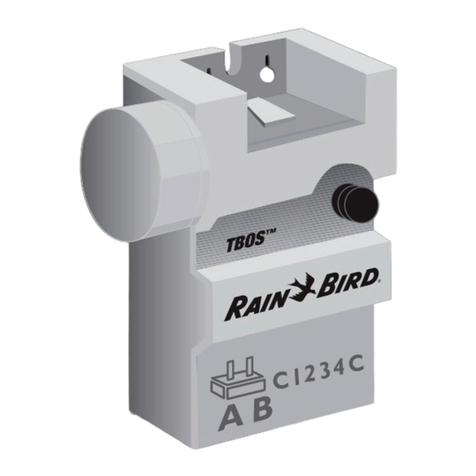
Rain Bird
Rain Bird TBOS manual

Vapotherm
Vapotherm Oxygen Assist Module Instructions for use

Automationdirect.com
Automationdirect.com Productivity 1000 P1-08TRS manual
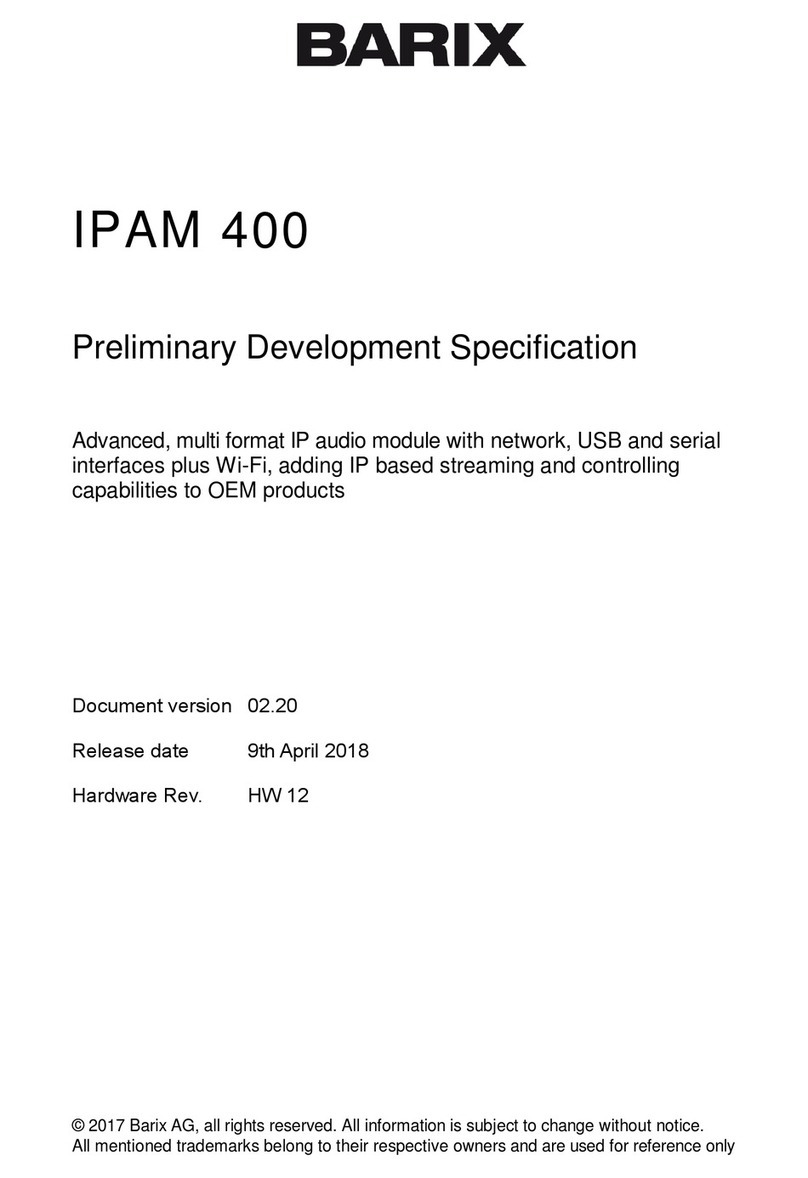
BARIX
BARIX IPAM 400 Preliminary Development Specification
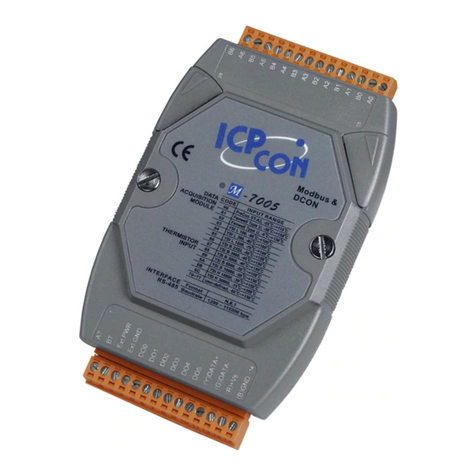
ICP DAS USA
ICP DAS USA M-7002 quick start guide
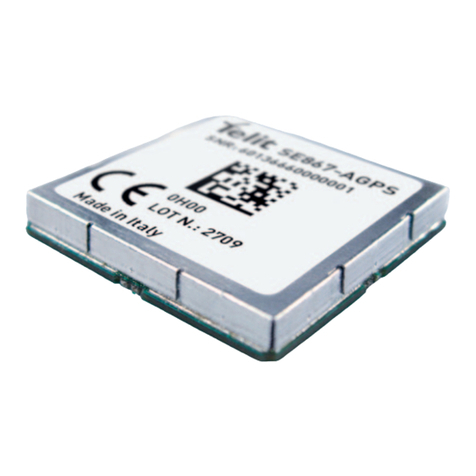
Telit Wireless Solutions
Telit Wireless Solutions SE867-AGPS user guide

